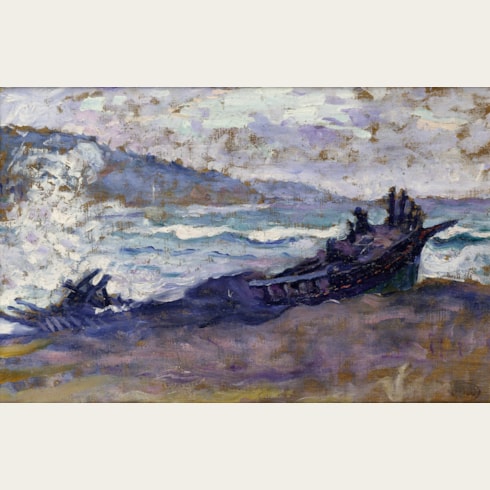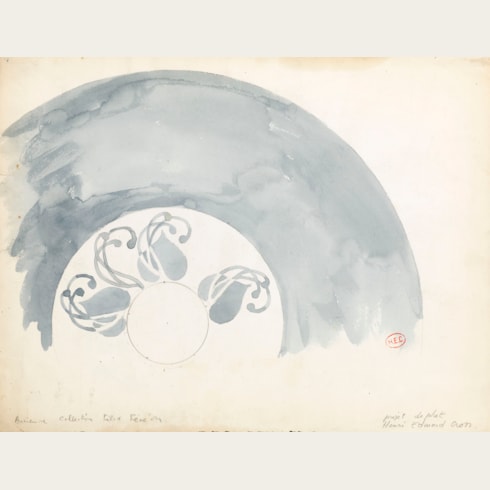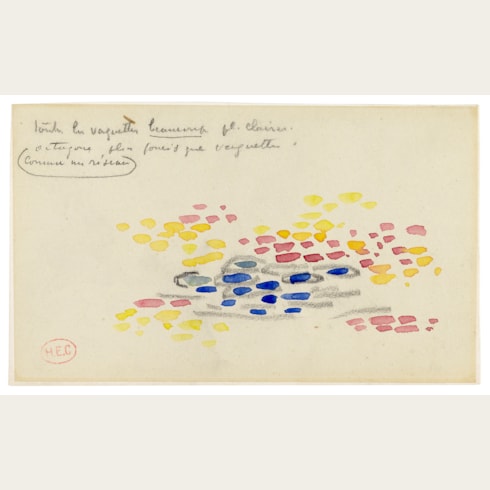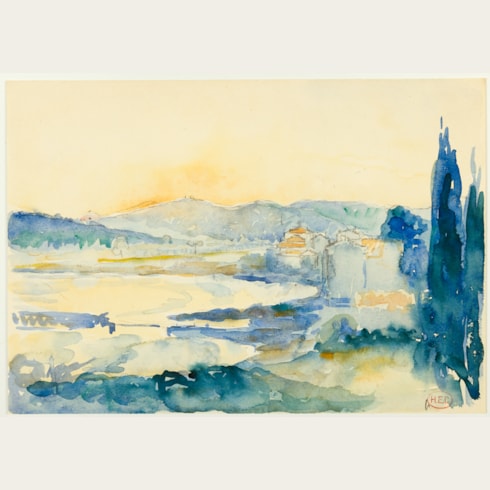Henri Edmond CROSS
(Douai 1856 - Saint-Clair 1910)
A Tree
Sold
Watercolour, over traces of an underdrawing in pencil.
Signed with initials HE.C at the lower left.
223 x 157 mm. (8 3/4 x 6 1/8 in.)
Signed with initials HE.C at the lower left.
223 x 157 mm. (8 3/4 x 6 1/8 in.)
Watercolours such as the present sheet occupied Cross throughout his career, and particularly in its later stages. In March 1900 Cross wrote to his fellow painter Charles Angrand that he was concentrating his activities on watercolour painting, adding that ‘C’est amusant. L’absolue nécessité d’être rapide, hardi, insolent même, apporte dans le travail une sorte de fièvre bienfaisante après le mois de langeur passés sur des peintures dont l’idée fut irréfléchie.’
Cross would make these drawings from nature, having already begun with an idea of what colour combinations and forms he would need, and having developed these basic ideas in the studio. As Cross wrote to one critic, ‘I compose in the studio, coming as close as possible to my interior vision; then, the harmony being established, partly on paper and canvas, and partly in my head, I set about making my sensations objective – sensations corresponding to the initial vision – in front of nature. These documentary sketches, during the definitive execution of the painting, more often than not are behind me or in a filing box.’
Datable to c.1905, the present sheet may be compared stylistically with such drawings as a watercolour study of trees at Saint-Clair, dated 1908, in the collection of the Musée des Beaux-Arts in Dijon. It is with reference to drawings like this that Cross would write in his notebooks aphorisms and aides-mémoires such as ‘Watercolour. A form of writing. The great role played by the paper. The Japanese.’ and ‘Not the object itself, but a transfiguration based on a concordance of lines, a harmony of color. A certain beautiful form embellished by certain magnificent colors will interest us: it might be that it corresponds to a tree.’
Cross would make these drawings from nature, having already begun with an idea of what colour combinations and forms he would need, and having developed these basic ideas in the studio. As Cross wrote to one critic, ‘I compose in the studio, coming as close as possible to my interior vision; then, the harmony being established, partly on paper and canvas, and partly in my head, I set about making my sensations objective – sensations corresponding to the initial vision – in front of nature. These documentary sketches, during the definitive execution of the painting, more often than not are behind me or in a filing box.’
Datable to c.1905, the present sheet may be compared stylistically with such drawings as a watercolour study of trees at Saint-Clair, dated 1908, in the collection of the Musée des Beaux-Arts in Dijon. It is with reference to drawings like this that Cross would write in his notebooks aphorisms and aides-mémoires such as ‘Watercolour. A form of writing. The great role played by the paper. The Japanese.’ and ‘Not the object itself, but a transfiguration based on a concordance of lines, a harmony of color. A certain beautiful form embellished by certain magnificent colors will interest us: it might be that it corresponds to a tree.’
Born in Douai to an English mother and a French father, Henri Edmond Delacroix studied first in Lille and later in Paris. Early in his career he changed his surname to Cross, an Anglicized version of croix, to avoid comparisons with the famous Romantic painter and confusion with a contemporary artist named Henri Eugène Delacroix. Little is known of his work before 1884, when he first exhibited with the Société des Artistes Indépendants, of which he was a founding member. Cross did not, however, adopt the Neo-Impressionist techniques of his colleagues Georges Seurat and Paul Signac until the early 1890’s, shortly after Seurat’s death. One of his first paintings in the pointillist technique was a portrait of his future wife, exhibited at the Salon des Indépendants in 1891 and today in the Musée d’Orsay in Paris. At around the same time he left Paris for the south of France, seeking to relieve his chronic rheumatism, and eventually settled in the village of Saint-Clair, near Le Lavandou in the Var region. The Mediterranean landscape of the Côte d’Azur was to become his preferred subject matter for the remainder of his career, although he also painted idyllic scenes of bathers and mythological figures.
From 1892 onwards Cross took part in all the exhibitions devoted to the Neo-Impressionist movement. His style became less rigid as his career progressed, however, with his paintings gradually adopting a greater freedom of brushwork than the more rigidly pointillist scenes of his close friend Signac. He also developed a brighter palette; the colours of his paintings reflecting his fascination with the light of the South. As Maurice Denis, a friend of the artist, noted in 1907, ‘Cross has resolved to represent the sun, not by bleaching his colours, but by exalting them, and by the boldness of his colour contrasts...The sun is not for him a phenomenon which makes everything white, but is a source of harmony which hots up nature’s colours, authorizes the most heightened colour-scale, and provides the subject for all sorts of colour fantasies.’ His friend and fellow Neo-Impressionist Paul Signac, who assembled a large personal collection of Cross’s paintings and watercolours, wrote of him that ‘One…feels in him the joy of panting, the love for delicate harmonies, something undefinably hesitant and mysterious and unexpected.’ Cross’s work may be said to have influenced such Fauve artists as Henri Matisse, André Derain, Louis Valtat and Henri Manguin, among others, who visited his studio in the Midi in the 1890’s and early 1900’s.
Towards the end of his career, Cross had largely stopped painting out of doors, preferring to make small watercolours from nature which were then developed into finished paintings in the studio. He was, however, never very productive as a painter, largely due to a combination of failing eyesight and severe arthritis, and from 1900 onwards painted relatively little. Cross’s first one-man exhibition of paintings and watercolours was held at the Galerie Druet in Paris in 1905, followed two years later by a retrospective exhibition at the Galerie Bernheim-Jeune, organized by his friend Felix Féneon, which included thirty-eight paintings and fifty-one watercolours. As one scholar has written of Cross, ‘By the time of his death, his work stood as a hymn to color and sunlight, and helped form the vision of the Mediterranean coast which is commonplace today.’
Provenance
Alexander Schick, Berlin
By descent to a private collection, until 2008.








